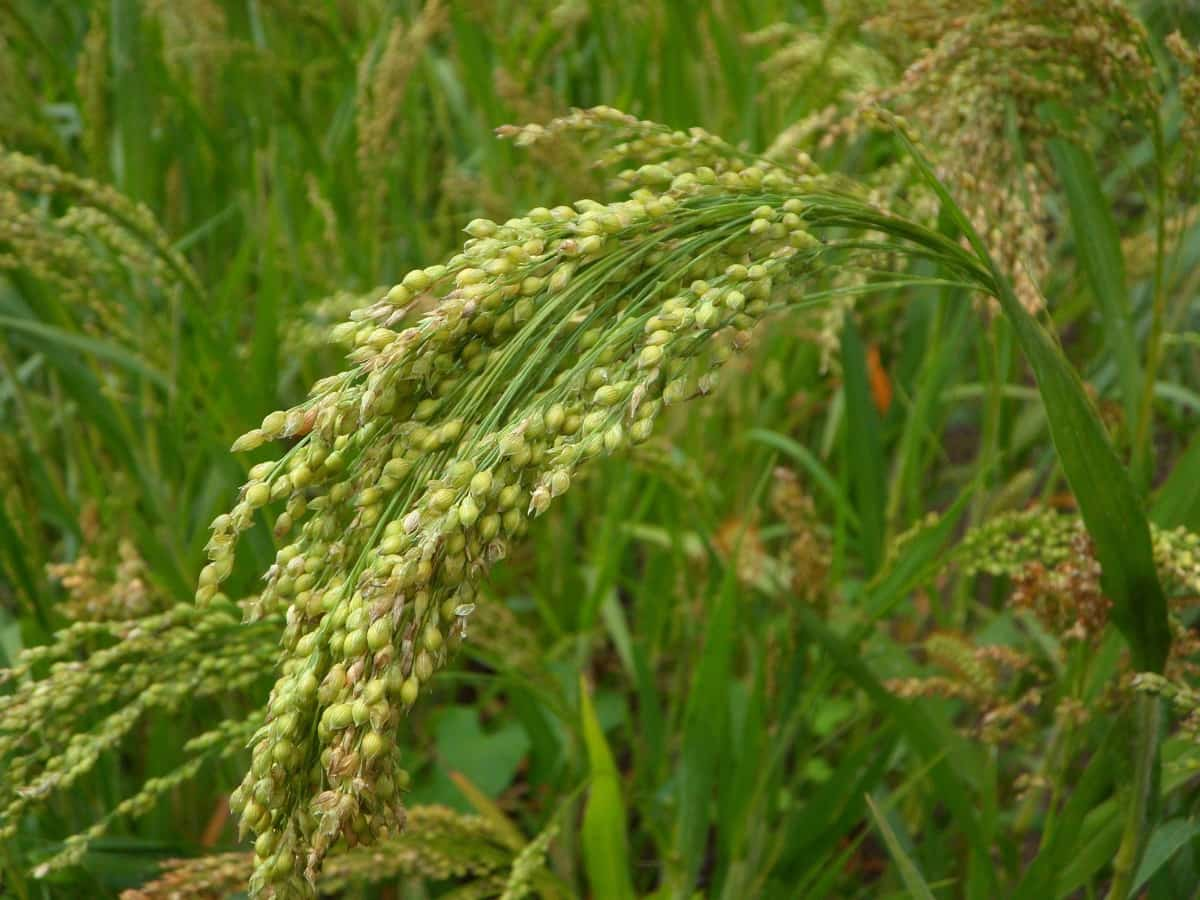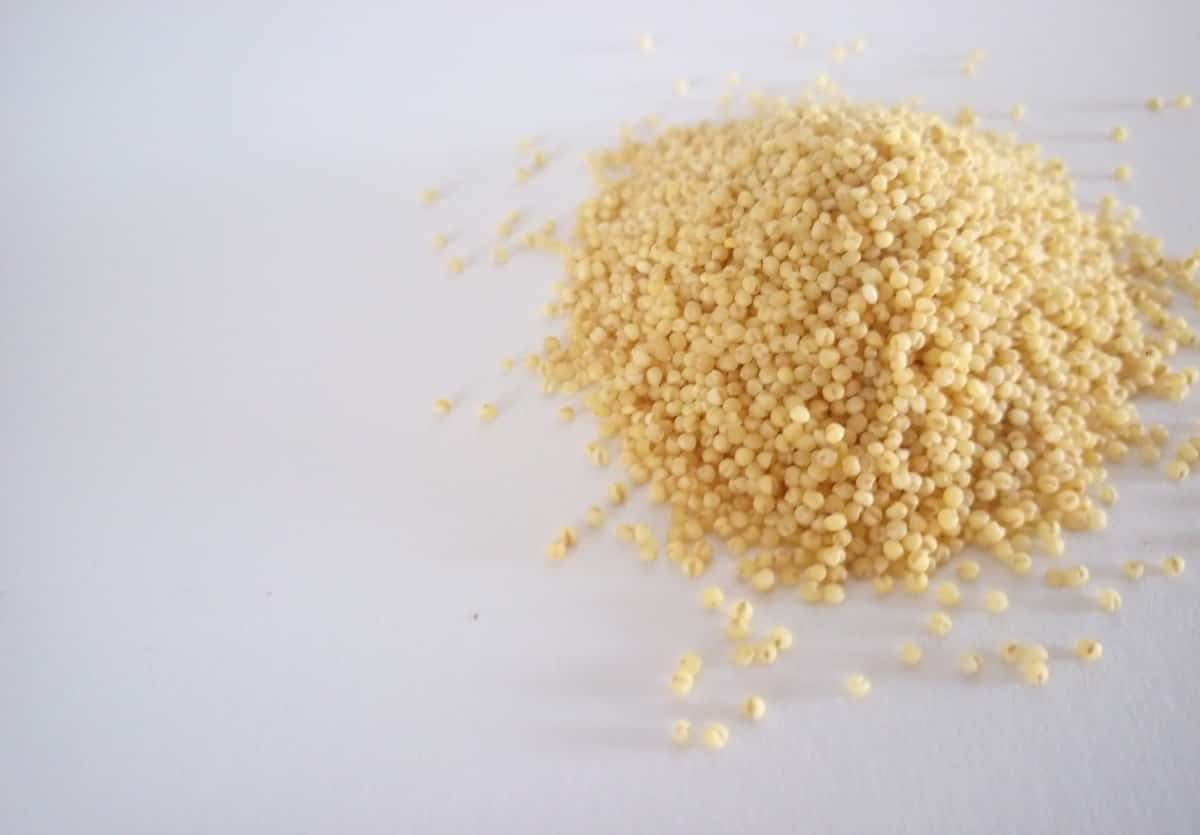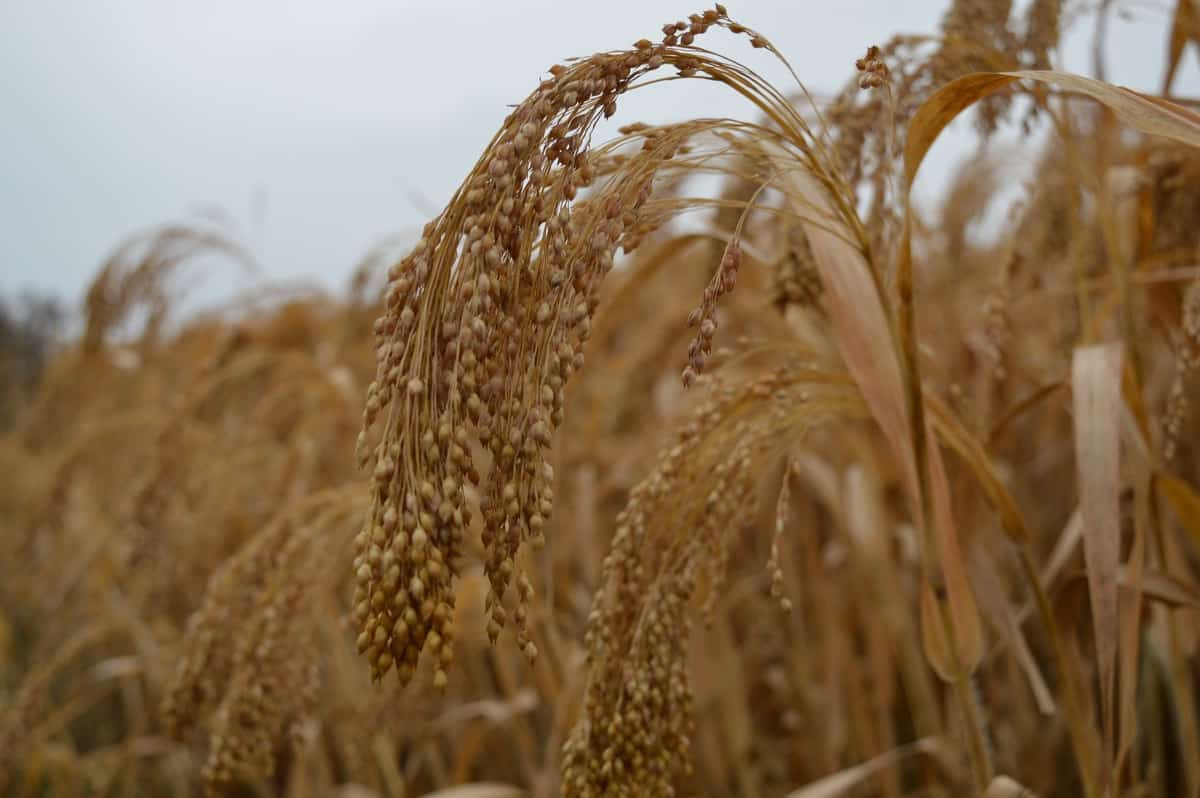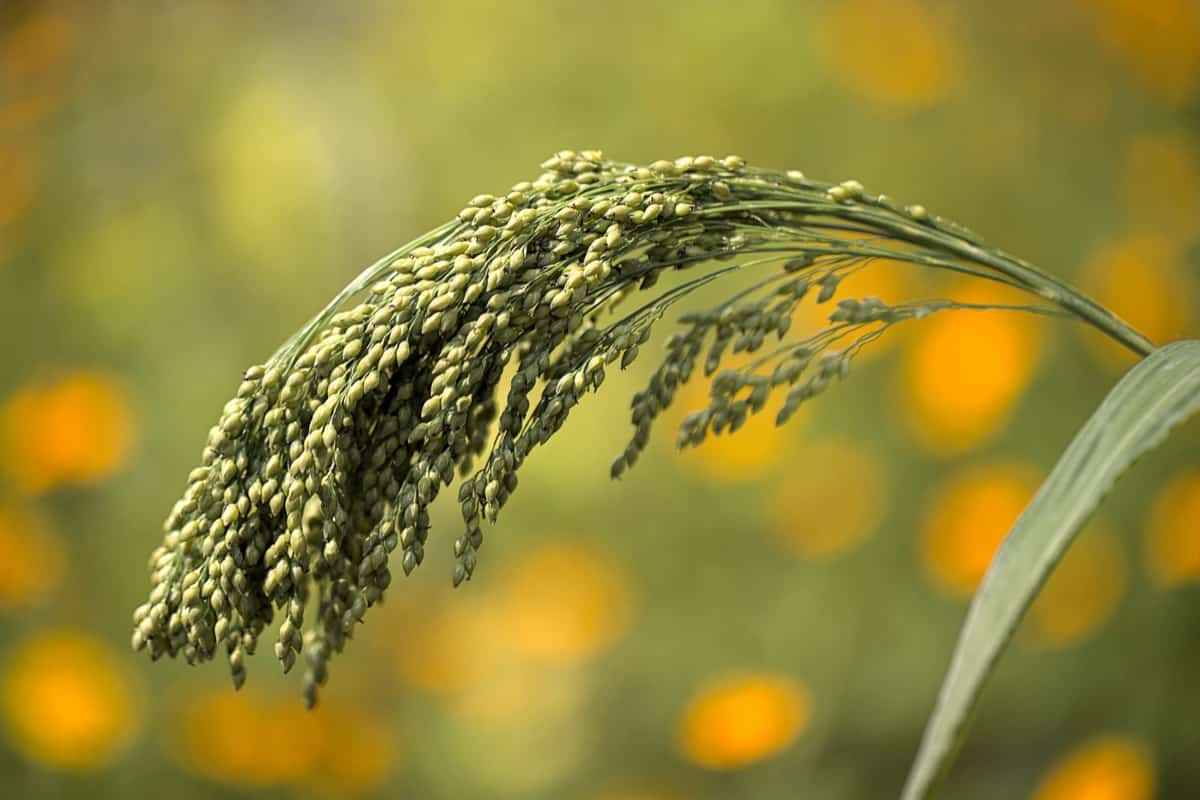Proso millet (Panicum miliaceum) is a type of millet grown for its grain and is a staple food in some parts of the world. It is native to Eurasia and has a long history of cultivation in China, India, and Eastern Europe. Proso millet is a small, round grain with a creamy white color and a mild, slightly sweet flavor. It is high in protein and is a good source of several essential nutrients, including B vitamins, iron, and zinc.

It is also naturally gluten-free, making it a suitable option for individuals with celiac disease or gluten intolerance. Proso millet can be cooked and eaten in a variety of ways. It can be ground into flour and used to make bread, pancakes, and other baked goods. It can also be cooked and eaten like rice, used as a cereal, or added to soups and stews for added texture and nutrition.
In some parts of the world, proso millet makes fermented foods like beer and spirits. Proso millet is a hardy crop that can grow in various conditions, including drought and low-fertility soil. It’s also resistant to pests and diseases., making it a popular choice for organic and sustainable agriculture.
Organic Proso Millet farming
About Proso Millet
Proso millet is an annual grass that grows to a height of about 2-4 feet. It has narrow, green leaves and small, inconspicuous flowers, usually yellow or brown. The plant produces small, round grains about the size of a pinhead. The grains are surrounded by a husk, which is removed during the threshing process. It has a short growing season and is typically ready for harvest in about 60-90 days.
The plant is resistant to pests and diseases, making it a popular choice for organic and sustainable agriculture. Proso millet is grown in a variety of climates around the world, including temperate and semi-arid regions. It is a primary staple food in some parts of the world, particularly in India, China, and Eastern Europe. It is also grown as a feed grain for livestock and as a cover crop to improve soil health.
Common names for Proso Millet in Asia
- China: Proso millet is called “xiaomai” in China and is a staple food in many parts of the country.
- India: In India, proso millet is called “ragi” or “finger millet” and is a primary staple food in the southern and western parts of the country.
- Japan: In Japan, proso millet is called “hie” or “Japanese barnyard millet” and is used to make traditional dishes such as onigiri (rice balls) and mochi (sticky rice cakes).
- Russia: In Russia, proso millet is called “chernozem” or “black earth millet” and is often used to make traditional dishes such as kasha (porridge) and kvass (fermented drink).
- Kazakhstan: In Kazakhstan, proso millet is called “qamys” and is a traditional staple food.
- Kyrgyzstan: In Kyrgyzstan, proso millet is called “toy” and is used to make traditional dishes such as beshbarmak (boiled meat and noodles) and kumis (fermented mare’s milk).
In case you missed it: Organic Little Millet Farming: Cultivation Practices and Production Management

Land preparation and soil requirements for Proso Millet
- Choose the right location: Proso millet grows best in well-draining, sandy soil with a pH of 6.0-7.0. It can grow in various environments, including temperate and semi-arid regions, but it requires plenty of sunlight and warmth to grow well.
- Prepare the soil: The soil should be loosened and cleared of weeds or debris before planting. If the soil lacks nutrients, you may need to add compost or other organic matter to enrich it. You can also test the soil pH and nutrient levels to determine if additional amendments are needed.
- Add organic matter: Adding organic matter such as compost or well-rotted manure to the soil can help to improve soil structure and fertility. This can help to promote healthy plant growth and increase crop yields.
- Control pests and diseases: Proper land preparation and soil management can help to prevent pests and diseases from taking hold in the soil. This may involve rotating crops, using pest and disease-resistant varieties, and applying pest and disease controls as needed.
- Irrigate: Proper watering is essential for proso millet farming. The soil should have been kept moist but not waterlogged, and irrigation should have been done based on the weather and soil moisture levels.
Temperature, climate & rainfall requirement for Millet farming
Proso millet is a hardy crop that can grow in various climates, but it grows best in warm, sunny conditions with plenty of moisture. Here are some general guidelines for temperature, climate, and rainfall requirements for proso millet farming:
- Temperature: Proso millet grows best in warm temperatures, with an optimal growing range of 70-80°F. It is sensitive to temperatures between 10 and 13°C. It is not tolerant of frost and should be planted after the risk of frost has passed.
- Climate: Proso millet grows well in various climates, temperate and semi-arid regions. It requires plenty of sunlight and warmth to grow well and is not tolerant of cold or wet conditions.
- Rainfall: Proso millet is a drought-tolerant crop that requires adequate moisture to grow well. Irrigating proso millet during dry spells is generally recommended 500-900mm to ensure that the soil stays moist. In regions with high rainfall, it is essential to ensure that the soil drains well to prevent waterlogging.
Proso Millet varieties
Thousands of All over the world improved hybrid varieties are grown. We may only be able to list some variety here.CO 4, K 2, CO(PV)5, PRC 1, and PR 18 are some of the high-yielding varieties. Contact your nearby agriculture department to find a high-yielding variety native to your area.
Proso Millet nursery raising and transplanting
Proso millet can be grown from seeds, sown directly in the soil, or started in a nursery and then transplanted. Here are the steps for raising proso millet in a nursery and transplanting it to the field:
- Start the seeds in a nursery: To start proso millet seeds, fill pots or trays with a seed starting mix and sow the seeds according to the package instructions. Water the seeds well and place them in a sunny location with a temperature of 70-80°F.
- Care for the seedlings: As the seedlings grow, keep the soil moist but not soggy, and fertilize as needed with a balanced fertilizer. You may also need to thin the seedlings to prevent overcrowding.
- Plant the seedlings as follows: When they reach 3-4 inches in height and have developed several true leaves, they are ready to be transplanted. To transplant, dig a hole in the field slightly larger than the pot or tray and carefully remove the seedling from the pot or tray. Place it in the hole and fill it around the roots with soil and water well.
In case you missed it: Organic Barley Farming: Production and Cultivation Management Practices

Spacing between plants in Proso Millet farming
- Sow seeds in rows: Proso millet seeds can be sown in rows, with the seeds spaced about 6 inches apart. Depending on the variety of millet being grown, the rows should be spaced about 12-18 inches apart. Sowing depth should be 1.5 to 2 cm in good soil and 3 to 4 cm in poor soil.
- Thin seedlings as needed: As the seedlings grow, you may need to thin them to prevent overcrowding. This can be done by carefully removing excess seedlings from the rows, leaving the remaining plants about 6 inches apart.
- Follow recommended plant spacing: Different varieties of proso millet may have specific plant spacing recommendations, so it is essential to follow the recommendations for the variety you are growing. This information can typically be found on the seed packet or by consulting with a local extension office or other agricultural experts.
Seed rate
Proso millet can be sown by broadcasting or drilling seeds 3-4 centimeters deep in furrows. Row-to-row distance should be kept at 25 centimeters, and plant-to-plant distance should be kept at 10 centimeters. Compared to broadcast sowing, line sowing ensures better germination, reduces seed requirements, and facilitates intercultural operations. 8-12 kg seed is required for sowing one hectare of land, depending on the method of sowing.
Proso Millet farming irrigation tips
Water regularly: Proso millet requires regular watering to ensure that the soil stays moist but not waterlogged. Water the plants deeply and consistently, as needed, to keep the soil moist. If the dry spell lasts for a long time, 1 – 2 irrigations should be applied during the tillering stage to increase yield. The first irrigation should be applied 25 – 30 days after sowing, followed by the second irrigation 40 – 45 days later.
- Use the right amount of water: It is essential to use the right amount of water when irrigating proso millet. Too much water can lead to waterlogging and root rot, while too little water can cause the plants to wilt and die.
- Monitor soil moisture levels: Keep an eye on the soil moisture levels to ensure that the plants get the right amount of water. You can do this using a soil moisture meter or simply feeling the soil with your fingers.
- Use drip irrigation: Drip irrigation is a good option for proso millet farming, as it allows you to deliver water directly to the roots of the plants, which can help to conserve water and reduce the risk of water loss due to evaporation.
- Consider the weather: The weather can significantly impact irrigation needs, so it is essential to monitor the weather and adjust your watering schedule as needed.
In case you missed it: How to Start Organic Farming in Brazil: Business Plan, Key Rules, Cost, Schemes, Loans, and Certification

Weed control practices in Proso Millet farming
Weeds can compete with proso millet for nutrients, water, and sunlight, which can reduce crop yields. Here are some tips for controlling weeds in proso millet farming:
- The field should be weed-free until 35 days to maximize yield while minimizing soil moisture and nutrient loss. Two weedings every 15-20 days would help control it. Weeding can be done with either a hand hoe or a wheel hoe.
- Use mulch: Applying a layer of mulch around the base of the proso millet plants can help to suppress weed growth. Mulch can also help to retain moisture in the soil and regulate soil temperature.
- Hand-weed: Hand-weeding can be an effective way to remove weeds from the proso millet field. This can be done by pulling the weeds out by hand or using a hoe to cut them off at the base.
- Use herbicides: Herbicides can kill weeds, but it is essential to use them carefully and follow the label instructions to avoid damaging the proso millet plants.
- Crop rotation: Rotating crops can help reduce weeds’ buildup, as different crops have different weed pressures. By rotating crops, you can help to reduce the number of weed seeds in the soil and reduce the need for herbicides.
Organic nutrient management
Before final ploughing, apply and plough in compost or farmyard manure at a rate of 5 tonnes per acre (12.5 tonnes per ha). Cattle penning can be used in place of this. As basal manure, 50 kg neem cake and 500 kg vermicompost per acre (125 kg neem cake and 1250 kg vermicompost per hectare) should be applied. Apply 50 kg/acre (125 kg/hectare) pungam cake and 250 kg/acre (600 kg/hectare) vermicompost as basal manure to rainfed crops before sowing.
Top dressing should be done 20 – 25 days after sowing using enriched vermicompost (2 kg Azospirillum, 2 kg Phosphobacterium, and 2 litres Panchagavya mixed with 250 kg vermicompost and kept covered for a week before use) @ 250 kg/acre (600 kg/ha). During the flower initiation stage, spray 10% tender coconut solution (1 litre of tender coconut water + 9 litres of water). The inputs, as mentioned above, should only be applied to a rainfed crop when the soil is wet.
In case you missed it: How to Start Organic Farming in Nigeria: Crops, Organic Vegetable Cultivation, Setup Cost, and Challenges

Pests and diseases in Proso Millet farming
- Shootfly: It is a major pest for this crop. This insect causes crop damage during the seedling stage.
- Rust: Rust is a fungal disease that can cause orange or red-brown bumps on the leaves, stems, and grains of proso millet plants.
- Leaf spots are a fungal disease that affects the leaves it can cause dark brown or black spots on the leaves of the proso millet plant.
- Fusarium wilt: is a disease that can affect many plants. It causes the leaves of proso millet plants to turn yellow and wilt. It can also affect the roots and stems of plants.
- Blast: Blast is a fungal disease that can cause circular or elongated spots on the leaves of proso millet plants. It can also affect the grains, causing them to become discolored or faded.
Organic management of pest & disease in Proso millet farming
- Use natural pest repellents: Several natural pest repellents can help to control pests in proso millet farming. These can include neem oil, garlic spray, and hot pepper spray.
- Use traps and barriers: Traps and barriers can effectively control certain pests, such as birds and rodents. These can include physical barriers, such as netting, and traps, such as sticky or bait traps.
- Use biological control agents: Biological control agents, such as predatory insects and fungi, can control pests in proso millet farming. These agents can help to control pest populations and reduce the need for pesticides naturally.
- Crop rotation: Rotating crops can help to reduce the buildup of diseases in the soil, as different crops have different disease pressures. By rotating crops, you can help to reduce the number of disease-causing organisms in the soil and reduce the need for chemical pesticides.
- Use resistant varieties: Some varieties of proso millet are more resistant to diseases than others. Therefore, you can reduce your crop’s disease risk by choosing resistant varieties.
Harvesting of Proso Millet
- Wait for the right time: Proso millet is typically ready for harvest when the grain is fully mature and the plants have turned yellow or brown. This usually occurs about 60-90 days after planting, depending on the variety and growing conditions.
- Cut the plants: The moisture content of the grains is approximately 15-20%. Use a sickle or sharp tool to cut the proso millet plants at the base, near the ground.
- Dry the plants: After cutting, lay, the proso millet plants out in a single layer to dry in the sun for a few days. This will help reduce the grain’s moisture content and make it easier to thresh.
- Thresh the grain: Use a flail or threshing machine to remove the grain from the plants. Alternatively, you can place the plants in a bag and beat them with a stick to remove the grain.
- Clean the grain: After threshing, use a winnowing basket or other tool to remove any remaining chaff or debris from the grain.
- Under ideal conditions, 2.5 to 4.5 tonnes/ha yields are possible.
- Store the grain: Once it is clean and dry, store it in a dry, airtight container to protect it from moisture and pests.
In case you missed it: How this Farmer Made 42 Lakhs from 5 Acres of Organic Pomegranate Farming: Fruit Cultivation Sucess Story in India

Proso Millet uses & benefits
- High in protein: Proso millet is a good source of protein, with about 7 grams of protein per 100 grams of cooked grain. This makes it a good option for vegetarians and vegans looking for plant-based protein sources.
- Gluten-free: Proso millet is naturally gluten-free, making it a suitable option for individuals with celiac disease or gluten intolerance.
- Good source of essential nutrients: Proso millet is a good source of several essential nutrients, including B vitamins, iron, and zinc. It is also rich in antioxidants, which can help to protect the body from harmful free radicals.
- Easy to digest: Proso millet is easy to digest and is often recommended for people with digestive issues or sensitivities.
- Sustainable and environmentally friendly: Proso millet is a hardy crop that can grow in various conditions, including drought and low-fertility soil. It is resistant to pests and diseases, making it a popular choice for organic and sustainable agriculture.
- Versatile: Proso millet can be used in various dishes, including bread, pancakes, cereals, and soups. It can be ground into flour or cooked and eaten like rice. This helps to make it a versatile ingredient that can be added to a variety of dishes.
- How to Build a Low-budget Goat Shed: Cheap Ideas and Tips
- Goat Farming Training Programs in India: A Beginner’s Guide
- Types of Pesticides Used in Agriculture: A Beginner’s Guide
- Economical Aquaculture: A Guide to Low-Budget Fish Farming
- 15 Common Planting Errors That Can Doom Your Fruit Trees
- How to Make Houseplants Bushy: Effective Tips and Ideas
- Innovative Strategies for Boosting Coconut Pollination and Yield
- Pollination Strategies for Maximum Pumpkin Yield
- The Complete Guide to Chicken Fattening: Strategies for Maximum Growth
- Natural Solutions for Tulip Problems: 100% Effective Remedies for Leaf and Bulb-Related Issues
- Revolutionizing Citrus Preservation: Towards a Healthier, Greener Future
- Natural Solutions for Peony Leaf and Flower Problems: 100% Effective Remedies
- Maximizing Profits with Avocado Contract Farming in India: A Comprehensive Guide
- Natural Solutions for Hydrangea Problems: 100% Effective Remedies for Leaf and Flowers
- The Ultimate Guide to Choosing the Perfect Foliage Friend: Bringing Life Indoors
- From Sunlight to Sustainability: 15 Ways to Use Solar Technology in Agriculture
- The Ultimate Guide to Dong Tao Chicken: Exploring from History to Raising
- The Eco-Friendly Makeover: How to Convert Your Unused Swimming Pool into a Fish Pond
- Mastering the Art of Delaware Chicken Farming: Essentials for Healthy Backyard Flocks
- 20 Best Homemade Fertilizers for Money Plant: DIY Recipes and Application Methods
- How to Craft a Comprehensive Free-Range Chicken Farming Business Plan
- Brighten Your Flock: Raising Easter Egger Chickens for Beauty and Bounty
- How to Optimize Your Poultry Egg Farm Business Plan with These Strategies
- Subsidy for Spirulina Cultivation: How Indian Government Schemes Encouraging Spirulina Farmers
- Ultimate Guide to Raising Dominique Chickens: Breeding, Feeding, Egg-Production, and Care
- Mastering the Art of Raising Jersey Giant Chickens: Care, Feeding, and More
- Ultimate Guide to Raising Legbar Chickens: Breeding, Farming Practices, Diet, Egg-Production
- How to Raise Welsummer Chickens: A Comprehensive Guide for Beginners
- How to Protect Indoor Plants in Winter: A Comprehensive Guide
- Ultimate Guide to Grow Bag Gardening: Tips, Tricks, and Planting Ideas for Urban Gardeners
- Guide to Lotus Cultivation: How to Propagate, Plant, Grow, Care, Cost, and Profit
- Agriculture Drone Subsidy Scheme: Government Kisan Subsidy, License, and How to Apply Online
- Ultimate Guide to Raising Araucana Chickens: Breed Profile, Farming Economics, Diet, and Care
- Bringing Hydroponics to Classroom: Importance, Benefits of Learning for School Students
- Ultimate Guide to Raising Polish Chickens: Breed Profile, Farming Economics, Diet, and Care
- Ultimate Guide to Raising Australorp Chickens: Profile, Farming Economics, Egg Production, Diet, and Care